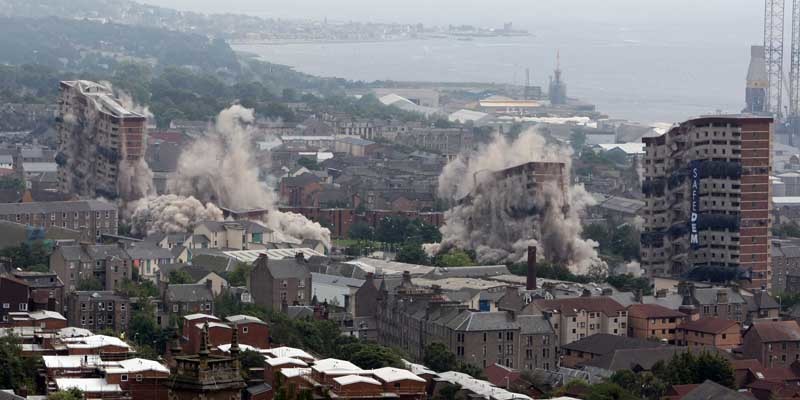The Dundee skyline changed for ever as the Alexander Street multis crashed to the ground in a spectacular controlled demolition.
The operation had been a huge test for Tayside Police who had to orchestrate the evacuation of the area early yesterday morning as well as conduct traffic duties whilst the exclusion zone around the multis was in place.
However, speaking shortly after the demolition, Chief Inspector David Barclay was full of praise for everyone involved and stated his delight at how things had been handled.
“It’s been absolutely superb and everything has been done exceptionally well,” he said.
“Safedem managed to get all of the buildings to fall on a sixpence and between them and the Dundee City Council staff, there was only limited input required from my staff.
“The dust cloud was a bit of a problem for a time but it’s good to see that nobody has been injured at all. We have had two or three broken windows which will be repaired, but that’s been about it.”
Work will now begin at the site to remove and process the rubble from the four multis, much of which will be recycled and re-used by the building trade.
That clear-up operation is expected to take around 20 weeks after which the land will be used to provide new housing.Click here to see videos of the end of the Alexander street multis.The four towers Maxwelltown, Carnegie, Jamaica and Wellington fell from the sky following months of careful preparation, causing shockwaves that could be felt for miles around.
Clouds of dust and dirt spewed into the air, clearing minutes later to confirm to thousands of spectators that the towers, after 43 years of standing over the city, were gone.
At one time the highest residences in Dundee, the landscape from across the Tay looked somewhat barren following the demise of the blocks that thousands of people once called their home.
However, the demolition of the multis marked the culmination of a gruelling project for local company Safedem, whose managing director and explosives engineer William Sinclair stated his delight at the operation.
“The demolition was perfect, absolutely perfect,” he said. “When you’re demolishing four buildings in a city centre you obviously have to be very thorough and very precise and the team did that.
“In total, we used 135kg of explosives and that was the absolute minimum needed to bring them down. We also used 4500 detonators in the operation and the result was just about as good as it gets.”
Hundreds of homes and businesses in the surrounding area had been evacuated leading up to the demolition, with many of those displaced heading to vantage points across Dundee and over the Tay.
Dundee Law has never been busier with hundreds of people heading to the city’s highest point for an eagle-eye view of the collapse. Large crowds also gathered on the Tay Road Bridge eager to watch the spectacle.
Following the towers’ demise, those living in the Hilltown area returned to find cars and buildings covered in dust from the explosion, however street sweeping machines were deployed to collect the worst of the material before the exclusion zone surrounding Alexander Street was lifted.
The Tay Road Bridge was subject to a rolling roadblock throughout the demolition, re-opening fully to vehicles shortly afterwards.
